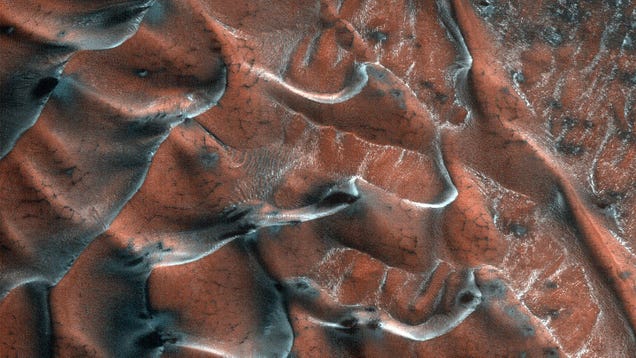Recent evidence gathered by China’s Zhurong rover points to a dramatic climate shift on Mars—a finding that could have a significant impact on our understanding of Earth’s climate evolution.
China’s Zhurong Mars rover collected rare evidence from the planet’s sand dunes that show a change in the direction of the wind, eroding the dunes’ crescent shape that formed during the glacial era. Instead, dark, longitudinal ridges now lay on top of the dunes located on the southern edge of Utopia Planitia, a vast series of volcanic plains on Mars.
Analysis of the data signals a dramatic shift in Mars’ climate 400,000 years ago that accompanied the changes in the wind, according to a recent study published in Nature.
Scientists have previously suggested that Mars underwent a climate change during its early history that made it less habitable. Previous studies of Mars’ climate, however, were not based on direct evidence from the Red Planet.
The Zhurong rover was able to directly measure and sample Mars’ geological formations using its surface composition analyzers and meteorological measuring instruments to obtain on-site evidence straight from the Martian surface. The rover itself has been presumed dead after not waking up from its winter hibernation mode in December 2022, but its data still lives on.
Data gathered by Zhurong from its surrounding landing spot found that the brighter, crescent-shaped dunes were buried beneath transverse aeolian ridges (TARs), which are made up of darker material. The TARs formed on top of the brighter dunes, albeit at a different angle. The team behind the recent study concluded that the prevailing wind direction on Utopia Planitia shifted nearly 70 degrees from northeast to northwest, eroding the crescent-shaped dunes around the same time as the end of the last major Martian ice age.
Mars likely exited its most recent ice age due to a shift in the planet’s rotational axis, which affects the position of the planet relative to the Sun. Those shifts in the angle at which a planet spins during its orbit around the Sun also take place on Earth and play a key role in the planet’s long term climate, according to NASA.
“The exploration and research on the climate evolution of Mars has been of great concern for a long time,” Li Chunlai, deputy director of the National Astronomical Observatories at the Chinese Academy of Sciences (NAOC) and principal investigator of the study, said in a statement. “Mars is the most similar planet to Earth in the solar system. Understanding Martian climate processes promises to uncover details of the evolution and history of Earth and other planets in our solar system.”
As China’s first Martian mission, the Zhurong rover landed on Mars on May 14, 2021. About a year after roaming and investigating the Red Planet, the rover entered hibernation—a low power safe mode—in anticipation of the chilly Martian winter. Zhurong was meant to end its otherworldly slumber at the start of springtime on Mars in December but it has not been heard from since.
Even during its interplanetary nap, the Zhurong rover continues to shed more light on the evolution of Mars.
